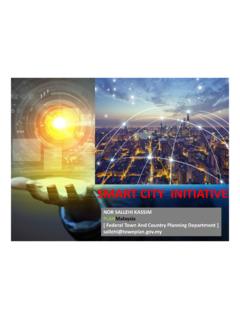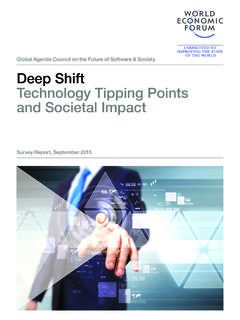Transcription of Smart cities: understanding the challenges and opportunities
1 Infrastructure intelligence in one place Smart cities : understanding the challenges and opportunities How do you make a city Smart ? That is the underlying question that unites the responses to the SmartCitiesWorld/Philips Lighting survey, which draws on input from 150 thought leaders from across the world in association with Introduction The Smart city concept will have different meanings in different cultures and can sound elusive until you break it down into practical terms. A good place to start is with the stupid realities many city dwellers ac- cept as part of their daily lives.
2 In some major cities , residents will spend four years of their lives trying to find a parking place. Elsewhere, they may find themselves stuck in an 182km-long traffic jam. Or they may have trouble sleeping because strong neon lights brighten up their street as if it were a soccer stadium. Using technology in particular the Internet of Things (IoT) and artificial intelligence to alleviate such situations would be good for citizens and cities . It is, for example, not uncommon in modern metropolises, for public lighting to account for half of the city's energy budget. In the short term, Smart LED lights could use 50 per cent less power than traditional lights.
3 (This is the very least that needs to happen if the world's cities are going to cope with their growing populations.) In the near future, as dumb' poles become Smart , they could form the digital backbone of a city, giving citizens and officials real-time, accurate information on anything from rush hour delays to air quality. Most urban governments embrace the compelling environmental, financial and social case for the development of Smart cities . What some are struggling with, as this SmartCitiesWorld/Philips Lighting survey un- derlines, is exactly how to implement such a programme.
4 If Smart cities are to become the new normal', local authorities and key decision makers need to navigate such difficult areas as technology, communications, data and security, knowing that costs can be difficult to predict and that the project will grow in complexity. Nor can they afford to underestimate the internal challenges , such as the need to engage other stakeholders, drive collaboration and break down silos. Political leaders, their careers determined by short-term electoral cycles, also need quick wins to maintain faith in a project. The purpose of this survey was to identify and explore what factors are driving or blocking the development of Smart cities , as enabled by the application of the Internet of Things and discuss ways to ease implementation.
5 The ultimate purpose of the Smart city' concept goes beyond such modest, if beneficial, initiatives as free Wi-Fi on public transportation, traffic calming and making doctor's appointments online. cities already consume more than 70 per cent of the world's energy supply. By 2050, of us will live in urban areas more than today. We need to use the Internet of Things to create efficient, sustainable cities if we are to live in an efficient, sustainable world. Writer: Paul Simpson Editor: Melony Rocque in association with 2. is a site focussed on creating a central pool of Smart infrastructure intelligence This online community enables you to keep abreast of the latest developments and trends in Smart cities The aim is to help foster the partnerships and dialogue between the key vertical sectors of Connectivity, Transport, Energy, Data, Buildings and Governance For more information please contact John O'Grady on 020 7933 8970.
6 Or 3. The key findings: Three best Smart cities in the world 1 Singapore 2 London 3 Barcelona Three most critical requirements for a Smart city Open data/sharing of data Citizen engagement Enhanced services for citizens Key components of a Smart city 68% Inter-operability of systems 57% City wide connectivity 51%. Security in association with 4. Key role for the Internet of Things in Smart cities Revolutionising the collection of data Revolutionising communications for accurate service delivery Managing strain on urban resources Things that would most ease implementation Visionary leadership Greater collaboration between agencies A Smart cities task force 34%.
7 Factors that inhibit implementation Budget limitations 1. More supporting infrastructure 2. Short-term mindsets 3. in association with 5. in association with 6. SmartCitiesWorld/Philips Lighting survey methodology SmartCitiesWorld, in conjunction with Philips Lighting, launched a worldwide survey that looked to understand and identify key attitudes and perceptions around the implemen- tation of the Smart city infrastructure. The survey sought to uncover perceptions and understanding of Smart cities and the Internet of Things from the viewpoint of different stakeholders. It also looked to identify the drivers and blockers to Smart city implementation and how the latter could be eased to enable successful, dynamic cities of the future.
8 The results of the survey were then used to commission this white paper on Smart cities , gathering views from the SmartCitiesWorld reader database on the challenges and opportunities that those working to implement a long-term vision face. Target Audience The audience targeted for the survey came from six main vertical categories of infra- structure providers (Connectivity, Data, Buildings, Transportation, Governance and Ener- gy) but also the R&D sectors and educational establishments. Which company/organisation were targeted: Governmental departments/regional authorities Policy-makers Investment community representatives OEMs Equipment manufacturers Facilities Management/Asset Management Service providers Network operators Systems integrators Which job functions were targeted?
9 CIOs, CTOs, CDOs (new functions addressing: innovation, information, technology, data). Mayors, City Department Heads/Managers Consultants Specifiers, architects and consultants Background to the survey questions Eighteen questions were asked in the survey which was split into various sections. These were: 1. Beliefs around Smart cities 2. challenges around implementation 3. Services & Cost Savings 4. Final Thoughts Over 150 thought leaders provided answers to the survey which ran between August and September 2017. Companies/organisations who we know completed the survey included: Dallas Regional Chamber (USA), Vodafone, Brisbane City Council (Australia), Ericsson, IBM, Chubb, York City Council (UK), Libelium, Dominion Holdings, BE Advisory, BBC, Nokia, Cisco, Transport for Greater Manchester (UK), Department for Environment (UK), Moscow City (Russia), Bristol City Council (UK), New York City Authority (USA), Ford, Barcelona City (Spain), Transport for London, Highways Agency (UK)
10 , EDF Energy, T-Mobile, Birmingham City Council, SNCF, Accenture, Kent County Council, Institute of Engineering Technologist, Harvard University, Royal Institute of Chartered Surveyors (UK), Ealing Council (UK), Charlotte City Authority (USA), City of Atlanta (USA), City of Ottowa (Canada), Washington DC Government (USA), Berlin City Council (Germany) and City of Prague (Czech). Countries responding to the survey include: United States of America, United Kingdom, Russia, Portugal, India, Israel, Finland, Spain, Germany, Canada, Italy, Australia, France, Slovenia, Japan, China, Belgium, Czech Republic and Romania.





